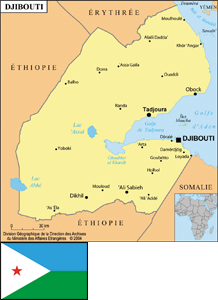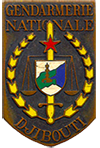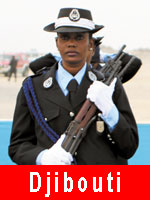
National Gendarmerie of Djibouti
|
1977 Ministry of attachment: Ministère de la Défense Workforce: 1 040 General manager: Colonel Zakaria HASSAN ADEN Address: Caserne Capitaine HAMADOU Tél.: (253) 21 32 08 01 Fax: (253) 21 35 48 42 Website: www.facebook.com/Djibgendarmerie.fr Communication Manager: Capitaine Hoummad LOITA HOUMMAD Tél.: (253) 21 32 08 16 Email: coop.gendarmerie.djibouti@gmail.com 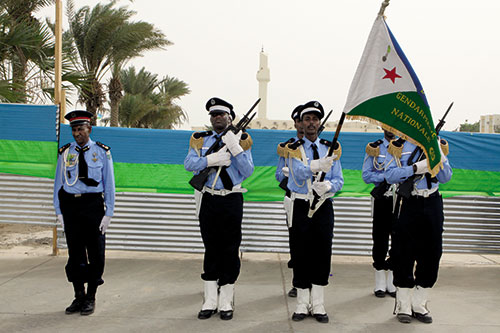
|
History
Before the independence proclaimed on June 27th, 1977, the French gendarmerie is present in this colony, called French Somaliland, since 1919. Arrived at the request of the governor, the first French gendarmes turn up in Djibouti with a detachment consisting of a head of brigade and two gendarmes. This number remains stable until 1945. After the World War II, according to the importance of the city development, the gendarmerie adapts its service and its organization. Whereas a central portion lives in Djibouti, several stations are established in Ali-Salieh, Dikhil, Tadjoura, Loyada and Arta. The gendarmerie of this period also includes mobile platoons and "guards" platoons through a local recruitment. The Djibouti Gendarmerie detachment is transformed in a group in 1957, then into a squad. In 1967, French Somaliland becomes the Afars and Issas French Territory (AIFT). On February 1976, within a political tension context bound to the pro-independence demands, the French "G.I.G.N." (National Gendarmerie Intervention Group) intervenes during the dramatic school bus hostage taking in Loyada. At the time of the independence, the Djibouti gendarmerie squad is composed of 700 men among whom there are local auxiliaries.
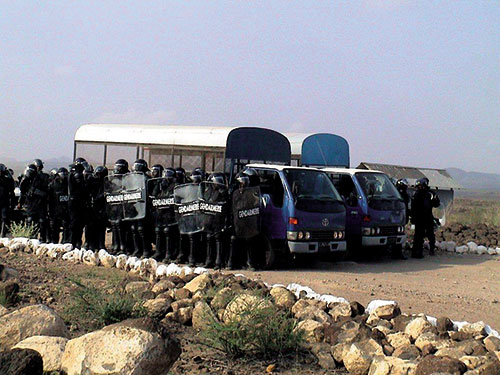
The Djiboutian gendarmerie is created on June 6th, 1977, with, at its head, a civilian director. In 1979, this director’s position is suppressed and the institution is placed under the authority of the Djiboutian joint staff chief. It constitutes a body of the national army. In 1991, the gendarmerie participates beside the other armed forces in the war against the Front for the Restoration of the Unity and the Democracy (FRUD). With the mobilized personnel, near one thousand men constitute its ranks. On January 1st, 1999, it acquires its institutional autonomy. It leaves the Djiboutian armed forces and is placed directly under the Minister of Defence’s orders. At its head is positioned a colonel appointed chief of staff of the National Gendarmerie. In 2002, the Djibouti National Gendarmerie is removed from the presidential security and the harbour surrounding-wall surveillance missions. Its workforce decreases. In 2007, it totalizes 680 servicemen. In 2008, the Djiboutian G.I.G.N. is created. In 2009, the Air Transportation gendarmerie is created, while the Navy coastguards’ ‘mission is transferred to the gendarmerie until 2011. In 2012, two mobile gendarmes squadrons are created.
Organization
The supervisory ministry is the Ministry of Defence.
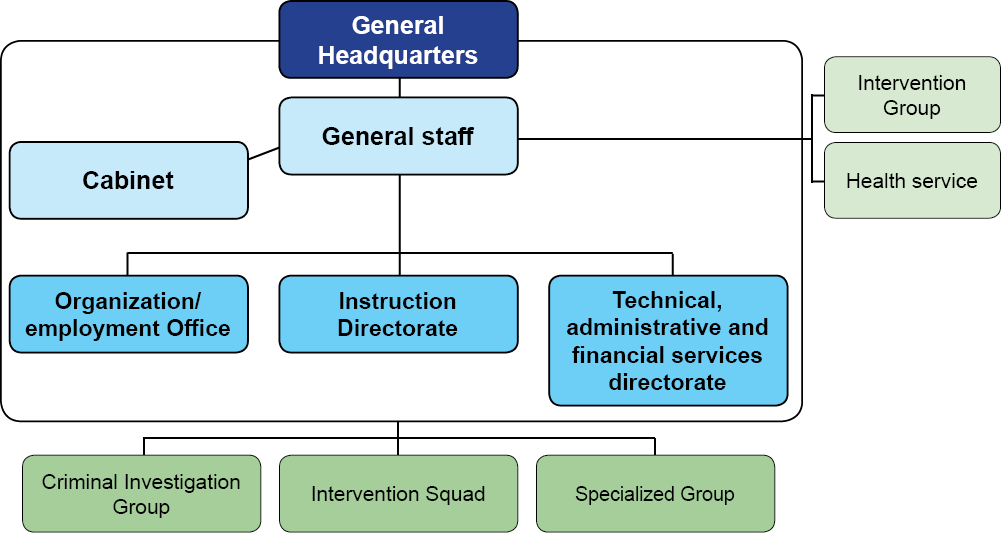
Central Organization
The Djibouti National Gendarmerie force-staff is composed of a cabinet, an organization-employment office, a directorate of instruction and a technical, administrative and financial services directorate.
Territorial organization
• The criminal investigation squad including the Djibouti (5 Gendarmerie brigades - GB), the interior (4 GB), & the Centre (3 GB and 3 stations) companies, and the Researches and Documentation Unit (RDU) possesses, since May 2012, an operational Fingerprints automated file.
• The Intervention Squad including the Services Squadron, the Intervention Multi-Purpose Unit (IMPU) and 2 Mobile Gendarmerie Platoon (MGP).
• The specialized squad composed of the road safety squadron (3 Motorized brigades) and the Air Transportation Gendarmerie located at Ambouli international airport.
Specialized Training
• The National Gendarmerie Intervention Group (G.I.G.N.) directly positioned under the National Gendarmerie Chief of staff’s orders.
• The health service.
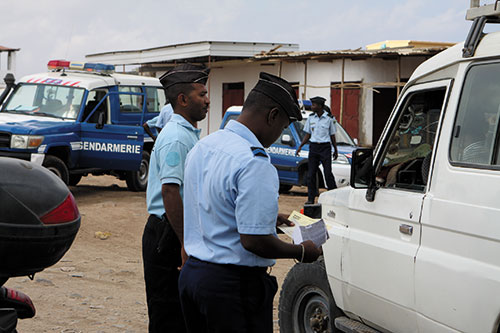
Missions
The Djibouti National Gendarmerie pertain to:
• The ministry of Justice for the Criminal Investigation Department;
• The ministry of the Interior for the maintenance of law and order and the public security;
• The ministry of the Equipment and Transports within the framework of its actions at the international airport and on the N°1 Main road (RN1). The Djiboutian gendarmes check and insure the RN1 road traffic fluidity, allowing the Ethiopian imports transport from Djibouti international harbour until the border. More than 800 trucks are using everyday these 220 km long axis.
Staff
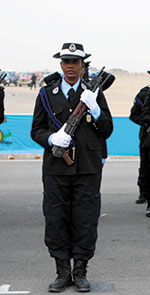 The gendarmerie includes men and women, servicemen and civilians. On January 1st, 2013, it counts in its rank 1 040 people divided up in the following way:
The gendarmerie includes men and women, servicemen and civilians. On January 1st, 2013, it counts in its rank 1 040 people divided up in the following way:
• 60 officers;
• 260 non-commissioned officers;
• 700 enlisted men;
• 20 civilians.
The feminization rate is of 5%. The staffs are recruited at the French General Certificate Secondary Education (GCSE) or the high school diploma level.
Training institutions
• On the national territory:
- Within the Cheick Moussa Instruction Center (CMIC), located at 23 km from the capital, for "All Units Elementary" Training, officers’ training courses and by means of Temporary Reinforcement Missions (TRM) granted by the DCSD,
- Within the General-Staff for the Criminal Police Officer training provided by a French gendarmerie officer;
- Within the French Forces staying in Djibouti for several trainings (Quartermaster’s stores, automobile workshop, automobile pool and mechanics’ administrators.) and CECAD training courses,
- Withn the “French Alliance” (“Alliance Française”) for French courses for the benefit of the French "National Gendarmerie Officers" School (E.O.G.N.) in Melun (France) and Criminal Police Officer (OPJ) candidates.
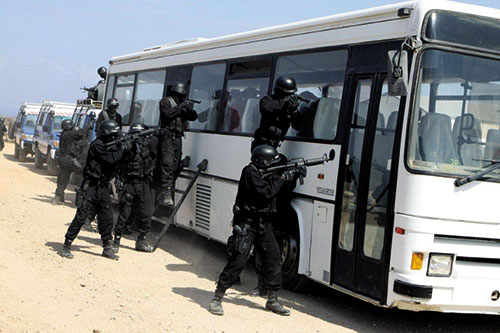
• In France:
- At the War School in Paris,
- Within the E.O.G.N. in Melun,
- At Fontainebleau (motorcyclist),
- At Satory (G.I.G.N.).
• In other countries:
- Within the national schools with regional vocation (ENVR) in Africa: Benin, Senegal, Cameroon, Burkina Faso, Mali and Gabon,
- In the United States of America,
- in Morocco,
- in the Bostwana.
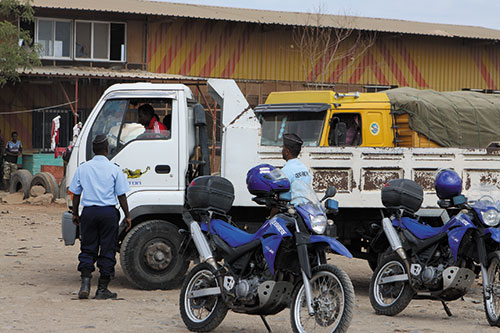
Main equipment
• Armament: PA, FAMAS and AK47.
• Vehicles: With regard to the ground, the fleet includes essentially 4x4 vehicles, trucks for the MGP and the motorcycles transport.
Cooperation
Since its creation, the Djibouti National Gendarmerie maintains links of cooperation with the French gendarmerie. At present, the French detachment includes:
• 1 Senior Officer, project manager and technical adviser of the Djibouti National Gendarmerie Staff Chief (NGSC);
• 1 officer, Criminal Police Officer’s instructor and legal advisor of the NGSC.
The Djibouti National Gendarmerie also develops partnerships with other countries:
• The United States of America. Example: 2 G.I.G.N. sections training in the USA, the delivery of a shooting simulator;
• Morocco and Bostwana for operational courses and training courses;
• Turkey with which some contacts are in progress.
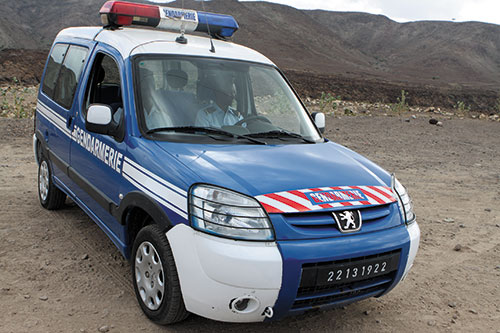
© The iconography was provided by the concerned gendarmeries

